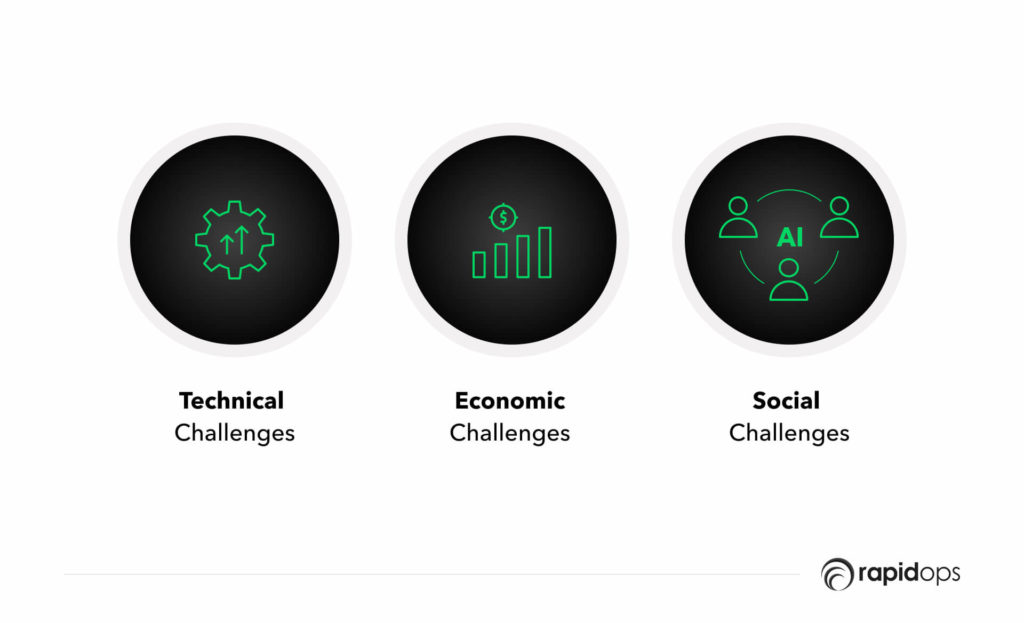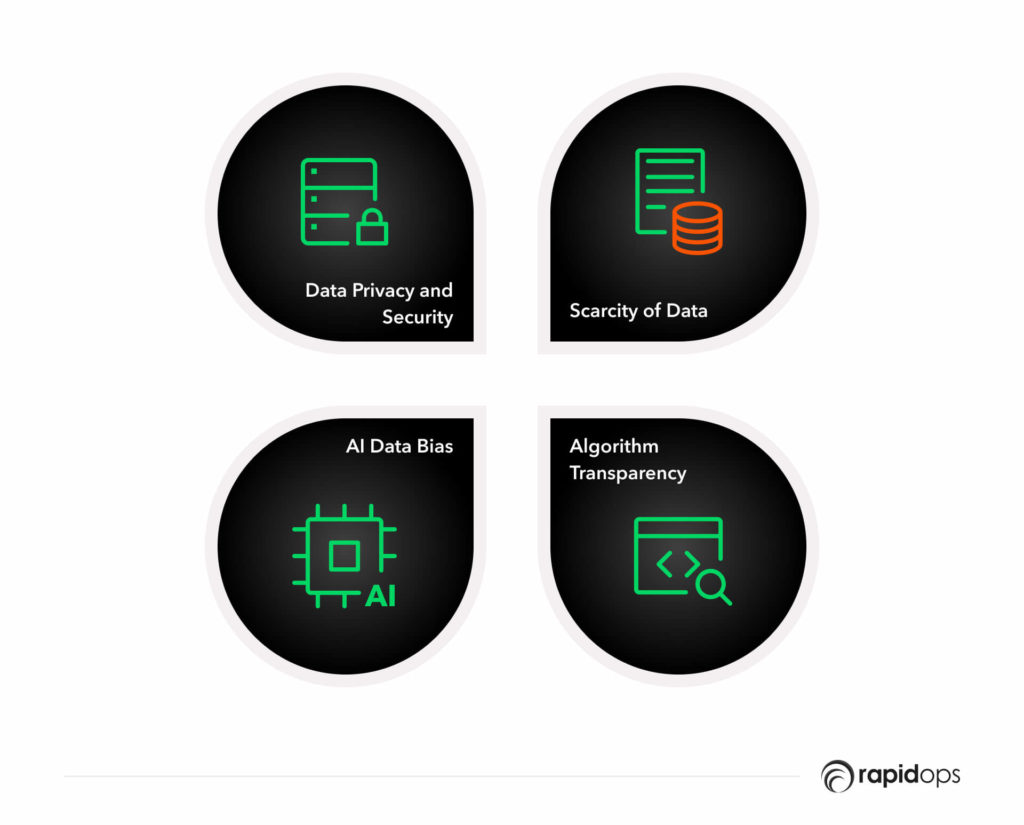As artificial intelligence is rapidly gaining popularity and acceptance, it also presents various challenges of AI implementation. Because of this growing acceptability of AI, several sectors have started investing in its research and implementation.
Artificial intelligence technology is revolutionizing
- manufacturing industries
- healthcare
- supply chain & logistics
- cybersecurity
- space exploration
- automated cars
- robots, etc.
One of the most significant challenges of AI is that it requires a lot of data gathering and analysis.
Here are some of the most prevalent problems businesses confront when attempting to implement artificial intelligence.
What are the challenges of AI (artificial intelligence)?
Implementation of artificial intelligence can be broadly classified into three categories:

1. Technical challenges
These challenges of AI arise due to the difficulty in programming AI systems, the need for vast data for training these systems, and the lack of understanding of how these systems work.
Technical difficulties as a challenge are perhaps the most demanding ones to overcome for modern businesses looking to implement the technology.
It is a known fact that AI technology is still in its early stages of development, and a lot is yet to be discovered about its working.
This means that creating AI systems that are effective can be difficult.
Furthermore, these systems require a large amount of data for practical training.
Also, the fact that this data is often difficult to obtain, in turn, affects the creation of a perfectly working AI system.
2. Economic challenges
These challenges include the high cost of AI technology and the lack of skilled workers.
The International Data Corporation (IDC) predicts that by 2023, $97.9 billion will be spent on AI technology.
AI is expanding steadily as more people embrace the concept of AI and has shown its effectiveness in today's digital world.
This growing need for AI also implies increased demands for people with AI expertise.
The fact is that AI technology is expensive, and there is a lack of skilled workers who can develop and operate these systems.
3. Social challenges
Social challenges are often related to ethical and privacy concerns surrounding AI technology, especially where public data is being collected, stored, and analyzed in a large number.
People, in general, are concerned that artificial intelligence (AI) system will violate their privacy and might be used to harm them.
The common challenges of artificial intelligence (AI)

Let's discuss the most common challenges of AI in this section and understand the seriousness of the issue businesses can face while implementing it in their processes.
1. Scarcity of data
An AI system's operation is based on data that has been trained and fed into it.
Most people are unaware that categorizing training data requires a significant investment in time.
Furthermore, an actual and complete data set must be used for training.
The ability to obtain high-quality data is detrimental to being categorized as a "good" or "bad" AI system in general.
Some very highly specialized AI technology is designed to handle one specific activity and improve as it learns.
Creating an AI system with the same level of intellect as humans to tackle broad challenges is still a significant challenge for researchers and practitioners.
2. Data privacy and security
The enormous amount of data used to train the AI system is gathered or created from millions of users.
These may be personally identifiable information. Due to this problem, AI systems may be vulnerable to data breaches and identity theft.
Creating a highly secure infrastructure to collect and preserve generated data is critical in confronting these issues.
3. Algorithm transparency
The brain of an AI system is the algorithms. AI systems, especially machine learning, rely on algorithms to make decisions or forecasts.
The more sophisticated these machine learning algorithms become, the greater their accuracy must be to ensure that they can discover patterns in data.
As a result, they're becoming increasingly difficult for people to comprehend.
Deep learning, for example, is a type of machine learning that may contain many layers of features and thousands of parameters, making it a "black box" with no transparency.
It's difficult to explain why someone made a particular decision or predicted something in simple terms.
4. AI data bias
The problem with AI systems is that their degree of "good" or "bad" is determined by the data they've been taught and how the algorithms label things like "good" or "bad.
Bias in data may be a result of ethnic, communal, gender, or racial prejudices.
The entire system might become faulty if the data and algorithms are tainted with bias, which has been a persistent problem in AI applications.
Facial recognition technology is vulnerable to bias and prejudice, according to research.
Many such systems have been trained on culture-biased image data sets primarily comprised of Caucasian male faces.
For example, the image databases of Google are primarily American and Western, with many claiming that they promote racist and sexist generalizations.
As a result of prevalent bias in most standard datasets, non-Caucasian populations and females are more prone to error or false identification.
A recent example of AI bias involves unions taking legal action against ride-hailing company Uber.
The lawsuit claims racial prejudice within Uber's driver verification software, resulting in the wrongful termination of drivers.
According to detailed research, facial recognition technology has a lower success rate with darker skin tones.
AI bias can also occur when AIs are utilized as proxies in crucial decision-making processes.
Can you overcome at least some of these challenges?
Well, like any challenge, challenges of AI can be dealt with the right technical expertise. So, let's help you understand how to do that.
1. Start by determining an exponential data set
It's challenging to choose which data to use since different sorts of data will flow between organizations.
Most of you are undoubtedly aware that AI systems are based on and improved using high-quality data.
This is why using pertinent data at the start of AI implementation is crucial.
If you want to improve AI's decision-making and learning capabilities, you'll need the appropriate data.
Businesses must collaborate with specialists in the field of artificial intelligence to assist them in navigating the correct path and method to achieve the intended results and deliver transformative digital experiences.
2. Focus on securing the data and its storage
Because AI applications draw on vast amounts of data, they require significant information.
The drawback of utilizing a lot of data is that it may cause business storage problems.
Furthermore, data-driven automation in commercial operations might cause security concerns.
This is why organizations must use data management solutions optimized for AI if they want its successful implementation.
A data management solution in this scenario would not just provide greater security to sensitive information but will also make it easier for businesses to gain access to data within separate silos.
3. Set a robust infrastructure
It's still difficult for most businesses to replace old, outdated technology with conventional legacy systems.
The computational speed of AI-based solutions is exceptionally high.
So, AI-based systems can operate faster if your company has an extensive infrastructure that supports high-end processors.
According to a recent McKinsey study, companies that are using AI technology are the ones that are ready to take their business journey into the digital age.
Businesses considering implementing artificial intelligence throughout their processes must prepare a robust infrastructure.
They must also have a sound technological architecture fully compatible with AI-based solutions or apps.
4. Integrate artificial intelligence with existing systems
When we talk about AI integration into existing business systems, most people may be surprised to learn that it is a struggle for most businesses.
In fact, one of the most prevalent problems that is majorly faced by organizations while implementing AI is 'scaling.'
Businesses wanting to integrate artificial intelligence into their current operations will require the assistance of AI solution providers with a lot of knowledge and expertise in AI, from planning to implementation.
5. The complex algorithms and AI model training
AI algorithms are crucial to the operation and performance of business intelligence processes.
The key to establishing an effective AI solution is to understand how AI-based technology or solutions operate and be able to change their outcomes.
When you've finished or developed AI-based solutions, you'll discover that keeping ML or AI models up to date may need a lot of time and labor, which may be challenging for businesses.
However, the benefits of deploying AI solutions in the business greatly outweigh the difficulties.
Concluding thoughts: Break past the noise; the growth possibilities are unprecedented.
Today, more AI and ML techniques and systems are used in factories, healthcare businesses, financial services, and security than ever before.
It's also being used on eCommerce platforms and social media websites like Facebook, Instagram, and mobile app platforms.
Rapidops has gained experience in providing the proper guidance to businesses that want to transform themselves and scale at an exponential rate digitally.
If you want to partner with an expert in the field of artificial intelligence to break past the noise and unlock unprecedented growth opportunities, then do get in touch with us.

Saptarshi Das
Content Editor
9+ years of expertise in content marketing, SEO, and SERP research. Creates informative, engaging content to achieve marketing goals. Empathetic approach and deep understanding of target audience needs. Expert in SEO optimization for maximum visibility. Your ideal content marketing strategist.

Let’s build the next big thing!
Share your ideas and vision with us to explore your digital opportunities
Similar Stories
- AI
- 4 Mins
- September 2022

- AI
- 9 Mins
- January 2023


Receive articles like this in your mailbox
Sign up to get weekly insights & inspiration in your inbox.

